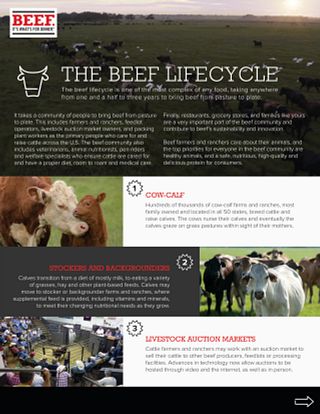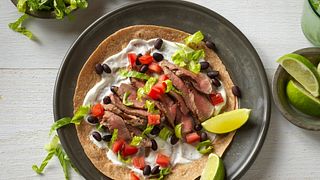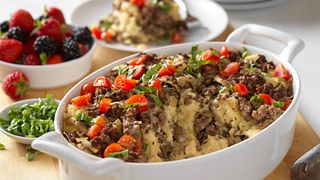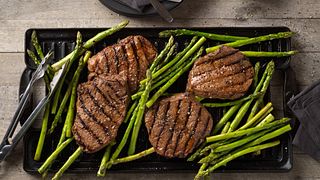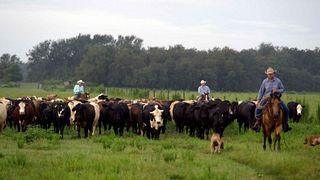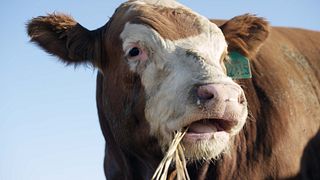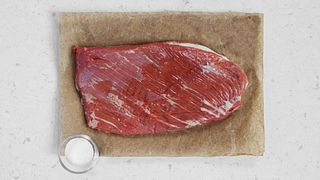Exploring the Beef Lifecycle
The journey of raising beef is among the most complex of any food. Due in part to their changing nutritional needs throughout their lifetime, beef cattle often times will change hands and ownership up to three or four times, over the course of one and a half to three years, as they move through their various life stages.
Across this process, however, one important thing remains constant – and that’s the beef community’s shared commitment to raising cattle in a safe, humane and environmentally sustainable way. Working together, each segment of the beef lifecycle aims to make the best use of vital natural resources like land, water and energy - not just for today, but also for the future. The result is a delicious and nutritious food you can feel good about serving your family and friends.
Let’s explore how beef gets from pasture to plate, including what cattle eat and several popular breeds in the U.S.
The Beef Lifecycle: From Pasture to Plate
Cow-Calf Farm or Ranch:
Raising beef begins with ranchers who maintain a herd of cows that give birth to calves once a year. When a calf is born, it typically weighs 60 to 100 pounds. Over the next few months, each calf will live off its mother’s milk and graze on grass pastures.
Weaning:
Calves are weaned from their mother’s milk at 6 to 10 months of age when they weigh between 450 and 700 pounds. These calves continue to graze on grass pastures and may begin receiving a small amount of supplemental plant based feed for extra energy and protein to help them grow and thrive.
Stocking and Backgrounders:
After weaning, cattle continue to grow and thrive by grazing on grass and pastures with ranchers providing supplemental feed including vitamins and minerals to meet all of their nutritional needs.
Livestock Auction Markets:
After weaning and/or during the stocker and backgrounder phase, cattle may be sold at livestock auction markets.
FeedYard:
Mature cattle are often moved to feedyards. Here cattle typically spend 4 to 6 months. They are free to graze at feed bunks containing a carefully balanced diet made up of roughage (such as hay and grass), grain (such as corn, wheat and soybean meal) and local renewable feed sources (more about that in the next section). Veterinarians, nutritionists and pen riders work together to provide individual care for each animal.
Learn more about animal safety and care at the feedyard.
Packing Plant:
Once cattle reach market weight (typically 1,200 to 1,400 pounds at 18 to 22 months of age), they are sent to a packing plant (also called a processing facility). United States Department of Agriculture (USDA) inspectors oversee the implementation of safety, animal welfare and quality standards from the time animals enter the plant until the final beef products are shipped to grocery stores and restaurants.
Popular Breeds of Cattle
Cattle come in many different shapes and sizes. While there are various physical differences, they have one thing in common: they all provide high quality, nourishing beef that can be part of a healthy diet.
Here’s an introduction to five popular cattle breeds in the U.S.

Angus
Angus is one of the most recognized cattle breeds, characterized by their black hides. They are popular with farmers and ranchers because they are good mothers and are very good at converting their feed into high-quality meat.

Charolais
Charolais cattle, (pronounced “char-lay”) originated from France and were brought to the U.S. in the mid-1930s. Charolais are generally white or creamy white in color. Charolais cattle can withstand cold temperatures relatively well and they are more heat tolerant than darker hided breeds.

hereford
The Hereford breed, (pronounced “her-furd”) was developed in England nearly 250 years ago by farmers who needed cattle that were good at converting native grass into lean muscle. They are generally a reddish-brown color with white markings, especially on their face.

simmental
The Simmental cattle breed is one with multiple color variations – there are both red and black Simmentals. They were introduced to the United States in the late 19th century because of their docility and mothering abilities.
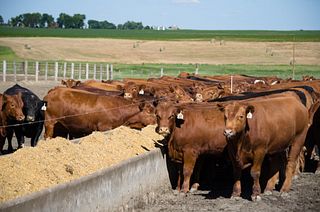
red angus
Yep, you read right. There are red Angus cattle! Although they are not raised as widely as black Angus, the beef Red Angus cattle provide offers similar marbling and flavor. These cattle are more heat tolerant than their black-hided relatives and are a docile cattle breed with good mothering traits.

